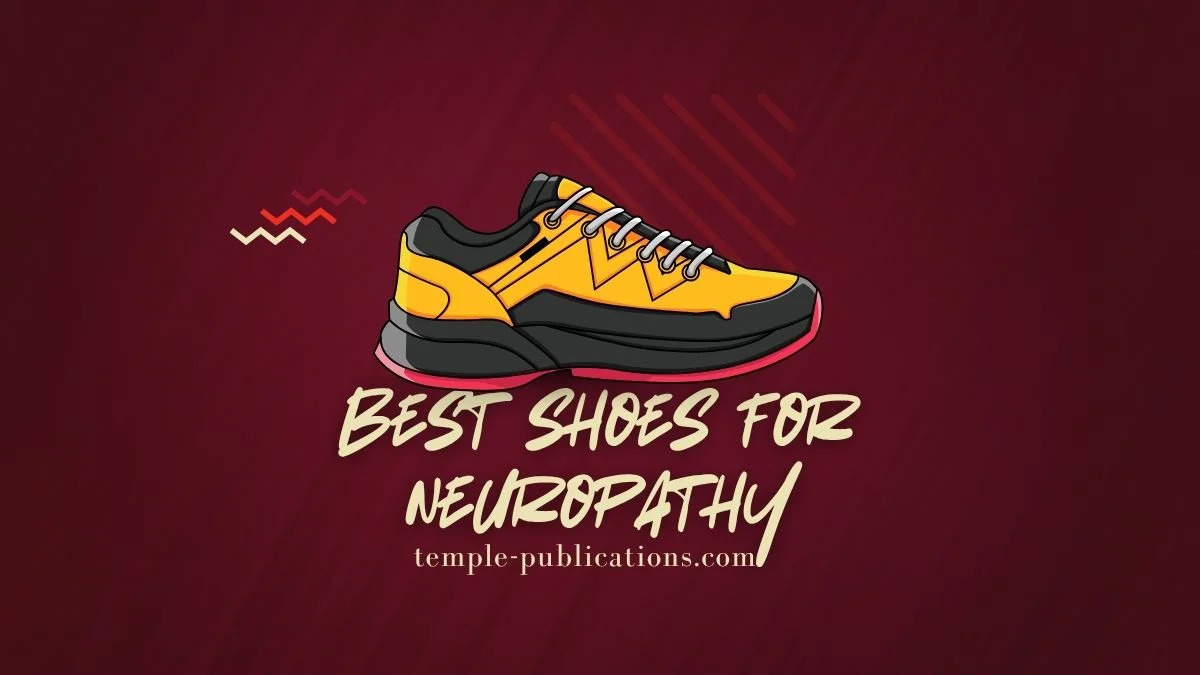HEALTH AND FITNESS
Best Shoes for Neuropathy: Top Picks for Comfort

Worldwide, up to 50 % of people with diabetes develop peripheral neuropathy, and foot pain is one of the leading reasons they stop exercising. If you feel stabbing, burning, or numb sensations each time you lace up, the right pair of shoes can ease pressure, cushion fragile nerves, and help you stay active.
What Is Neuropathy in Feet?
Neuropathy in feet, also known as peripheral neuropathy, is a condition caused by damage to the peripheral nerves, often resulting in pain, numbness, tingling, or weakness in the feet. It commonly affects people with diabetes but can also be triggered by infections, injuries, vitamin deficiencies, or exposure to toxins.
How do the Right Shoes Help?
A range of scientific studies say that comfortable, rocker-soled shoes reduce plantar pressure levels by up to 30 % and that they also lessen the variation in walking speed, both important in ulcer prevention. Such footwear is helpful for diabetics, as it guides proper positioning and improves stability on uneven surfaces by leveling proprioceptive responses.
Key Features
- Wide, seamless toe box – prevents friction blisters.
- Max cushioning midsole – disperses forces and dampens vibration.
- Removable insole – accommodates custom orthotics or gel layers.
- Secure closure – laces, straps, or knit collars that hug without pinching.
- Slip-resistant outsole – reduces fall risk on slick floors.
- APMA-approved models – vetted by podiatrists for foot health.
Best Shoes for Neuropathy
The 2025 review which studied 30-day wear trials and heel-mapping in the lab, recommended six top-rated shoes: Hoka Bondi 8, Hoka Clifton 9, New Balance 990v6, Skechers Arch Fit Max Cushioning, Orthofeet Edgewater and Propet Stability Walker.
- Hoka Bondi 8 – 40 mm stack height softens heel-strike shocks.
- New Balance 990v6 – firm ENCAP midsole plus Ortholite® liner; comes in 2E-6E widths.
- Skechers Arch Fit Max Cushioning – podiatrist-certified insole with 20 years of data.
Best Shoes for Neuropathy for Women
Foot swelling and the confinement of narrow heels are usual experiences for women with neuropathy. Select styles that include stretch-mesh uppers and heel-lock contours which are part of Hoka Clifton 9 and Skechers Go Walk Joy. A minimal Meta-Rocker design in Clifton supports forward movement and helps relieve pressure on the front of your feet; Joy Go Walks provide light 5GEN cushioning to minimize tiredness during long shifts.
Best Shoes for Men
Often, good arch and depth support is important for men. Dual-density medial posts are featured on the New Balance 860v14, which can help prevent over-pronation, and the Orthofeet Lava has been given the Medicare code A5500 for reimbursement for diabetic shoes. The upper of the shoe can stretch up by one size during edema swelling.
-
Work scenarios
Keen Utility PTC Dress Oxford adds slip-resistant rubber rated ASTM F1677.
-
Running
Hoka Arahi 7 blends plush CMEVA foam with J-Frame™ sidewalls to keep stride neutral.
-
Skechers Shoes for Neuropathy
Designing Skechers’ Arch Fit involved study of 120,000-foot impressions, resulting in an insert that fits the mid-foot and changes how pressure is distributed. Go Walk 6 and Arch Fit Max Cushioning bear the APMA Seal, and you can buy them for under $100.
-
New Balance Shoes for Neuropathy
As well as headlining 990v6, New Balance includes Fresh Foam X in shoes like the 1080v13 to merge softening comfort with a bouncy effect. With broad or extra-broad lasts (2E–6E), the shoe respects your meaty forefeet and firmly built heel walls provide vital support for your sensitive heels.
-
Hoka Shoes for Neuropathy
The Bondi 8 and Gaviota 5 from Hoka use oversized CMEVA midsoles and a Meta-Rocker which are known to help decrease metatarsal peak pressures. A gusseted tongue on the Bondi stops lace bite from affecting numb feet.
-
Best Slip-On Shoes for Neuropathy
Designs that don’t require holding make it easier for people with back or balance problems to use devices. The Heel Pillow™ in the Skechers Ultra Flex 3.0 Slip-ins cups your heel as you put on the slip-ons and the stretch-knit material eliminates bothersome seams. Those with neuropathy state that the shoes are both light and fit securely.
Best Shoes for Specific Neuropathy
Diabetic Neuropathy:
Because Orthofeet Edgewater shoe is Medicare-approved A5500 footwear, it can be reimbursed and has extra-deep insoles for custom plastazote liners.
Chemo-Induced Neuropathy:
Cushioned, rocker designs (e.g., Hoka Clifton 9) ease tenderness in the ball of the foot.
Severe Numbness:
Vibram-grip outsoles (New Balance 880 Trail) offer tactile feedback on uneven paths.
Top 6 Best Shoes for Neuropathy
| Brand | Model | Stand-out Feature | Best For |
| Hoka | Bondi 8 | 40 mm max-cushion rocker | Long days, heel pain |
| New Balance | 990v6 | ENCAP midsole + 2E-6E widths | Walking, everyday wear |
| Skechers | Arch Fit Max Cushioning | Podiatrist-certified insole | Budget therapy |
| Skechers | Ultra Flex 3.0 Slip-ins | Hands-free heel cradle | Limited dexterity |
| Orthofeet | Edgewater | Medicare A5500 depth | Severe diabetic neuropathy |
| Propet | Stability Walker | Firm TPU heel counter | Seniors, fall-prevention |
Tips for Finding the Right Fit
Check your size standing, with the pair of socks you are going to wear. Make sure there is a thumb’s worth of space between your longest toe and the end of the shoe; walk on an incline to test if your heels move in the shoe. A new pair should be put in the next day, as foam regains 15 % of its original height overnight. Get new shoes if you notice the tread wearing down or the midsole starting to compress in different places (around 400–500 miles).
“Shoes should feel comfortable the moment you put them on; breaking-in is a myth for neuropathic feet.” — American Podiatric Medical Association
Final Thoughts: Comfort Beats Style
Using the Best Shoes for Neuropathy can prevent or delay the start of it. Choose comfort, support, and thickness before color choices when looking for shoes. Try on your shoes at home on the carpet, and if any part of the shoe feels wrong, return them right away—diabetic nerve problems won’t give you a signal later on. For excessive calluses, get examined by a podiatrist, who may recommend orthotics.
FAQs
Are Skechers good for neuropathic feet?
Yes. The Arch Fit series carries the APMA Seal, provides certified arch support, and includes roomy toe boxes that limit friction.
Which Hoka model helps most with foot pain?
Bondi 8 offers Hoka’s thickest CMEVA midsole and a Meta-Rocker that rolls weight forward, easing pressure on sore forefeet.
Can the right shoes reverse neuropathy?
Best Shoes for Neuropathy can’t reverse nerve damage, but they reduce pain, improve balance, and prevent ulcers that might otherwise lead to infection or amputation.
Does Medicare cover neuropathy shoes?
Yes, Medicare Part B may reimburse one pair per year if the shoes carry an A5500 code and you have a physician’s prescription for diabetic neuropathy.
How often should I replace neuropathy shoes?
Every 6–12 months or 400–500 miles, whichever comes first, because midsole compression reduces shock absorption over time.
-

 BIOGRAPHY7 months ago
BIOGRAPHY7 months agoBehind the Scenes with Sandra Orlow: An Exclusive Interview
-

 HOME1 year ago
HOME1 year agoDiscovering Insights: A Deep Dive into the //vital-mag.net blog
-

 HOME1 year ago
HOME1 year agoSifangds in Action: Real-Life Applications and Success Stories
-

 BIOGRAPHY1 year ago
BIOGRAPHY1 year agoThe Woman Behind the Comedian: Meet Andrew Santino Wife




























